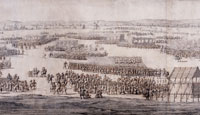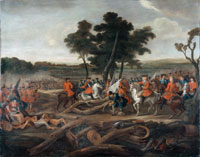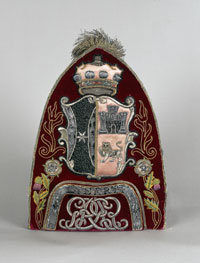

Grand Review of the British Army on Hounslow Heath

NAM 2002-11-682
Absolute power
This drawing by Willem van de Velde the Elder shows one of the earliest formal gatherings of the Army in either 1687 or 1689. The reviews from 1685 to 1688 were the last occasions on which a monarch was able to demonstrate his absolute control of the Army without Parliamentary authority. When King James II came to the throne in 1685, the Army was crucial to the development of his domestic policy. He needed a power that would enable him to introduce unpopular reforms, particularly Catholic emancipation, and support his absolutist style of government. James increased the size of the Army and set about turning it into a ‘modern’ force. Hounslow Heath was an area of open land west of London. Lying between Windsor Castle and the seat of government at Westminster, it was an ideal location for a military muster. Introducing an annual military muster so close to London had deliberate political significance as a demonstration to the people of the power behind the monarchy. James’ attempts to secure religious toleration for Catholicism, alongside the dismissal of Protestant officers from his Army, led a small group of rebel officers to invite his son-in-law, William of Orange, to England. James fled and, in the Glorious Revolution of 1688, a Protestant monarchy was reinstated under William III.
Lace from the ruff of William III’s coat, worn at the Battle of the Boyne, 11 July 1690

NAM 2001-11-178
A Protestant Army for a Protestant State?
This piece of blood stained lace belonged to King William III whose victory at the Battle of the Boyne near Drogheda helped secure not only a Protestant succession to the throne, but also a Protestant dominated Army. This was in the aftermath of King James II’s attempt to increase Catholic representation in the Army in order to ensure its loyalty to the crown. As well as helping to turn the war in Ireland in William’s favour, the battle grew to be an important symbol of Protestant dominance. For this reason, the battle is still celebrated by Unionists and Loyalists on 12 July each year. They remember it as a great victory over Catholics and responsible for the sovereignty of Parliament and a Protestant monarchy. However, Irish Nationalists and Catholics see the battle as part of the wider British colonisation of their country. The battle has thus been a controversial topic for both sides on the sectarian divide during the Irish ‘Troubles’.
Battle of Malplaquet, 11 September 1709

NAM 1973-08-103
Bloodbath at Malplaquet
The Battle of Malplaquet in 1709 was the bloodiest engagement of * (1702-1713). Malplaquet lies close to the French border, about 9 miles (15km) from the Belgian town of Mons. It was here, on 11 September 1709, that an Allied army commanded by the Duke of Marlborough and Prince Eugene, engaged a French army under Marshal Villars. The French occupied a strong defensive position, but after desperate hand-to-hand fighting the Allies won the day at a cost of over 20,000 men. These were some of the heaviest casualties seen in eighteenth century warfare and Marlborough’s popularity declined as a result. The Allies had suffered so many casualties that they were prevented from marching on Paris, so the battle was a strategic victory for France. The death toll at Malplaquet was to traumatize the nations of Europe just as much as the horrific loss of life at the Somme and Verdun did over hundred years later.
Seal of the Duke of Cumberland

NAM 1963-10-253
Lost and found at Fontenoy
The The Battle of Fontenoy on 11 May 1745 was a French victory during the War of the Austrian Succession (1742-48). Whilst the Duke of Cumberland's (1721-1765) attack on the superior positions of the French army showed little tactical skill and his Anglo-Hanoverian forces had to retreat, he showed great personal courage during the fight. During the struggle he lost his brass seal, which was later found by Sergeant Dunesme of the Gardes Francaises, a regiment that had been heavily engaged against the British infantry. Although Fontenoy had demonstrated the fighting qualities of the British infantry, it was none the less a defeat that resulted in the Austrian Netherlands being overrun by the French.
18th century grenadier cap

NAM 1999-07-31
A thing of rare beauty
The design on this velvet embroidered grenadier cap depicts the arms of Sir John Hobart, Earl of Buckingham, who was Lord Lieutenant of the County of Norfolk. He raised the Norwich Artillery Company in January 1746 for the defence of the City against possible invasion during the Jacobite Rebellion of 1745-1746. This rare item of headdress could have been worn by one of only four officers serving in the Company, including Hobart himself, and is unique in bearing the arms of a private individual rather than the Crown. Ad-hoc units like the Norwich Artillery stand in a long tradition of part-time soldiers who have supplemented the standing Army. These forces were often assembled to defend against invasion or for maintaining domestic order. Later examples include the Militia, Territorials and Home Guard.

